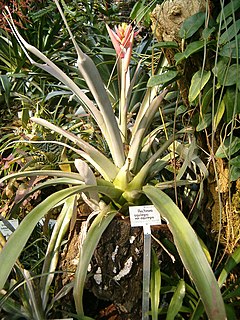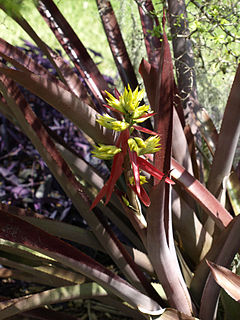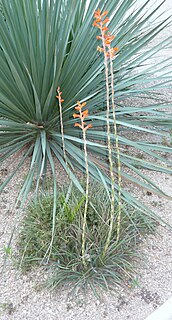
Cryptanthus is a genus of flowering plants in the family Bromeliaceae, subfamily Bromelioideae. The genus name is from the Greek cryptos (hidden) and anthos (flower). This genus has two recognized subgenera: the type subgenus and HoplocryptanthusMez. All species of this genus are endemic to Brazil. The common name for any Cryptanthus is "Earth star".

Aechmea nudicaulis is a bromeliad species in the genus Aechmea, which is often used as an ornamental plant. This species is native to Central America, the West Indies, central and southern Mexico, and northern and central South America.

Nidularium is a genus in the plant family Bromeliaceae, subfamily Bromelioideae. Named to describe the nestling characteristic of the inflorescence, all the species are endemic to Brazil. Commonly confused with Neoregelia which they resemble, this plant group was first described in 1854.

Hohenbergia stellata is a perennial species of the genus Hohenbergia. It is native to Trinidad and Tobago, Martinique, Netherlands Antilles, Venezuela, and northeastern Brazil.

Dyckia leptostachya is a plant species in the genus Dyckia. This species is native to Brazil, Bolivia, Paraguay, and Argentina.

Aechmea calyculata is a species of flowering plant in the Bromeliaceae family.
Aechmea alba is a species of plant in the genus Aechmea. This species is endemic to Brazil.

Aechmea aquilega is a plant species in the genus Aechmea. This species is native to Brazil, Venezuela, the Guianas, Trinidad, Jamaica and Costa Rica.

Aechmea bambusoides is a plant species in the genus Aechmea. This species is endemic to Brazil. It is native to the States of Minas Gerais and Rio de Janeiro. Mature fruits (berries) are pyriform, white and contain seeds spread in a fleshy transparent mucilage. Seeds are falcate-shaped, with a narrow micropylar portion, rough texture, brown-red colour and no appendages.
Aechmea bicolor is a plant species in the genus Aechmea. This species is endemic to the State of Santa Catarina in southern Brazil.
Aechmea burle-marxii is a plant species in the genus Aechmea. This species is endemic to Brazil, known from Bahia and Minas Gerais.
Aechmea caesia is a plant species in the genus Aechmea. This species is endemic to the State of Rio de Janeiro in Brazil.
Wittmackia canaliculata is a species of plant in the family Bromeliaceae. This species is endemic to the State of Bahia in Brazil.

Aechmea comata is a species of flowering plant in the Bromeliaceae family. This species is endemic to southern Brazil.

Aechmea emmerichiae is a species in the genus Aechmea. This species is endemic to Chapada Diamantina National Park in eastern Brazil.

Guzmania monostachia is an epiphytic species in the genus Guzmania. Also known as a West Indian tufted airplant, this species is native to South America, Central America, the West Indies and Florida. The species is also reportedly naturalized in Hawaii.

Tillandsia gardneri is a species in the genus Tillandsia. This species is native to Trinidad & Tobago, Colombia, eastern Brazil and Venezuela.
Tillandsia polystachia is a species in the genus Tillandsia. This species is native to Central America, the West Indies, Bolivia, Colombia, Brazil, Ecuador, Mexico and Venezuela.

Tillandsia tenuifolia, the narrowleaf airplant, is a species in the genus Tillandsia. This species is widespread across much of South America and the Caribbean islands.

Dyckia remotiflora is a plant species in the genus Dyckia. It is native to Argentina, Uruguay, and Brazil.













